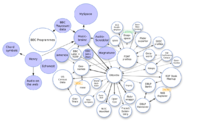
Photo from wikipedia
Background Big data from large, government-sponsored surveys and data sets offers researchers opportunities to conduct population-based studies of important health issues in the United States, as well as develop preliminary… Click to show full abstract
Background Big data from large, government-sponsored surveys and data sets offers researchers opportunities to conduct population-based studies of important health issues in the United States, as well as develop preliminary data to support proposed future work. Yet, navigating these national data sources is challenging. Despite the widespread availability of national data, there is little guidance for researchers on how to access and evaluate the use of these resources. Objective Our aim was to identify and summarize a comprehensive list of federally sponsored, health- and health care–related data sources that are accessible in the public domain in order to facilitate their use by researchers. Methods We conducted a systematic mapping review of government sources of health-related data on US populations and with active or recent (previous 10 years) data collection. The key measures were government sponsor, overview and purpose of data, population of interest, sampling design, sample size, data collection methodology, type and description of data, and cost to obtain data. Convergent synthesis was used to aggregate findings. Results Among 106 unique data sources, 57 met the inclusion criteria. Data sources were classified as survey or assessment data (n=30, 53%), trends data (n=27, 47%), summative processed data (n=27, 47%), primary registry data (n=17, 30%), and evaluative data (n=11, 19%). Most (n=39, 68%) served more than 1 purpose. The population of interest included individuals/patients (n=40, 70%), providers (n=15, 26%), and health care sites and systems (n=14, 25%). The sources collected data on demographic (n=44, 77%) and clinical information (n=35, 61%), health behaviors (n=24, 42%), provider or practice characteristics (n=22, 39%), health care costs (n=17, 30%), and laboratory tests (n=8, 14%). Most (n=43, 75%) offered free data sets. Conclusions A broad scope of national health data is accessible to researchers. These data provide insights into important health issues and the nation’s health care system while eliminating the burden of primary data collection. Data standardization and uniformity were uncommon across government entities, highlighting a need to improve data consistency. Secondary analyses of national data are a feasible, cost-efficient means to address national health concerns.
Journal Title: Journal of Medical Internet Research
Year Published: 2023
Link to full text (if available)
Share on Social Media: Sign Up to like & get
recommendations!